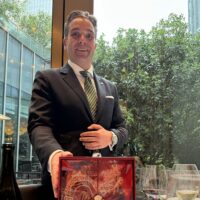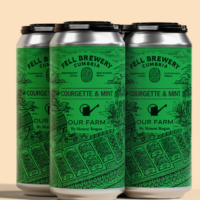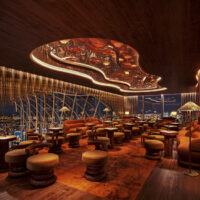Made in the on-trade

The appeal of a chef ambassador is twofold; not only are they credible advocates for the quality and taste profile of a wine, but powerful gatekeepers to the on-trade.
“Traditionally, wine brands are built in the on-trade; this is the natural environment to let the product shine and customers have the expert guidance of sommeliers on hand to help them tackle the wine list,” says Carfantan. “However, food and wine pairing takes things to the next level, and there is integrity when aligning with a professional chef; there is no more credible ambassador to speak about the harmony of food and wine marrying around a certain dish. It is the ultimate in experiential marketing for today’s consumer.”
Overall, sales of Champagne in the on- and off-trade are growing, but not thriving in the UK. According to Nielsen, the volume of Champagne sold in the UK off-trade to the end of December suffered a 20% decline in volume and an 11% fall in value, bringing the number of bottles sold through UK retailers down from 16.7m in 2016 to 13.3m in 2017. The picture is slightly more positive in the on-trade, but only when assessing the premium end of the market. Data company CGA Strategy reported a three-year decline, with volumes falling from a peak of £440m in 2015, to £373.3m in 2017. Volumes, meanwhile, have fallen from 54,737 hectolitres in 2014 to 40,638 in 2017.
“Three years ago the Champagne category was benefitting from the premiumisation trend, and the growing tendency for consumers to drink Champagne as a treat,” says Jonathan Jones, director of client services at CGA.
“The category was seeing volume growth of 5% year-on-year. However, fast-forward three years and volumes are now declining at 12% year-on-year, and showing little sign of recovery. In this same period, Champagne’s share of total UK on-trade Champagne and sparkling wine volumes has fallen from 45% to just 20%, while Prosecco has capitalised on the same changing consumer demands but at a more accessible price point. With the price of Champagne being three times that of other sparkling wines, it still holds more than 40% of the value sales, and still provides a trade-up opportunity for operators and licencees.”
Slowdown in growth

Spiros Malandrakis, senior analyst at Euromonitor, paints a similar picture, believing Champagne’s performance in the on-trade will “get worse before it gets better”, as Brexit negotiations progress.
“I would expect at best a slowdown in the growth of both the on- and off-trade,” he says. “Obviously, the on-trade is more susceptible, but my expectation is more on the negative side. The UK is one of the key markets for Champagne globally. Whatever happens in the UK has a global impact on Champagne sales.
Currency exchange issues over the past year have already put pressure on Champagne sales, because it has to be imported. On top of that we have the Brexit saga, which is about to get worse. Last year was also been a really bad year for production, with some producers discussing price increases of 10%-30%, so it’s a triple whammy. Distributors and retailers tend to be open-minded to absorbing some increases. I don’t think it will all be passed onto consumers, but producers are feeling the pressure.”

Increasing competition has caused Champagne to feel the pinch. Since 2013, Champagne’s share of the UK on-trade has shrunk, according to Liberty Wines. However, it’s not all doom and gloom. Importantly, Liberty’s Premium On-Trade Wine Report 2018 divides the on-trade into ‘premium’ outlets, based on factors including cost and commercial reputation, and ‘outside premium’, with the former outperforming the latter.
In the ‘premium’ on-trade, sales of Champagne are growing. Value growth has been more than double the volume increase each year (+3% by volume, +8% by value in 2017), reflecting demand for more premium marques. It is outside of the premium on-trade that Champagne sales are declining (-18% by volume, -15% by value), the report states, confirming that the premium on-trade remains the key for Champagne growth.
“Premium on-trade sparkling wine drinkers have become more adventurous, and now expect to see other sparkling wines on wine lists, notably English and Welsh,” the report states. “This growing demand has meant sales of English and Welsh wines have more than doubled between 2013 and 2017.
Outside premium, Prosecco has decimated Champagne’s volume and value market share and also hampered the growth of other sparkling wines. This suggests that the prospect of building sales of higher-priced Champagne in the premium on-trade still exists, together with premium Prosecco.”
In the ‘premium’ on-trade Champagne’s value share of the sparkling wine market has fallen from 71% in 2013 to 62% (-9%) in 2017, while volume share has dropped from 69% to 38% (-31%). ‘Outside’ premium, value share dropped from 71% to 40% (-31%), while volume share has shrunk from 46% to 20% (-25%), while Prosecco has increased its share in both sectors.
Overall, the average bottle price for Champagne has grown in the premium on-trade by 26% between 2013 and 2017. Outside of premium, “as cheaper sparkling wines and discounted Prosecco have taken hold, average bottle prices of all sparkling wines are declining across the board”, the report states, with the exception of Champagne, which, on price, has performed positively in both sectors.
As David Gleave MW, managing director of Liberty Wines, adds: “We have seen a shift in the Champagne market. It used to be that ‘Champagne’ was the brand people requested, so cheaper examples were listed alongside more expensive ones. Now, increasingly knowledgeable and discriminating consumers are asking for Grand Marque premium producers by name. They are the brand, rather than the Champagne as a whole.”




